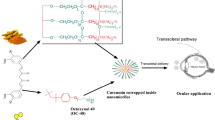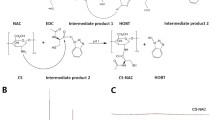Abstract
Ocular drug delivery has been a well-known route for the drug administration for the treatment of ocular diseases. However, numerous anatomical and physiological barriers prevailing in the eye itself create considerable challenges for achieving the necessitated therapeutic efficacy along with ocular bioavailability. However, recent advances in nanoengineered strategies hold definite promises in terms of devising improved ophthalmic medicines for the effective drug delivery to target the sites with enhanced ocular bioavailability. Curcumin, a hydrophobic polyphenol yellow colored compound, and its metabolic reduced product, tetrahydrocurcumin (THC), have been known for their beneficial pharmacological functions, such as anti-inflammatory or anti-oxidant activities at various tissue sites. However, the low aqueous solubility of these compounds results in their poor bioavailability, thereby limiting their widespread application. Therefore, in the present study, we investigated the changes in drug solubility by forming inclusion complexes with different derivatives of hydroxypropyl (HP)-cyclodextrins (CD). To this end, the spray drying technique was used for nanoengineering curcumin or THC-loaded formulations to improve the stability of formulations during the storage. The formulations were characterized in terms of physicochemical properties and cellular permeability. The results demonstrated that the encapsulation of curcumin (or THC) into the HP-CDs significantly increased the drug solubility and enhanced the corneal and retinal epithelial permeability. Curcumin or THC complexes in HP-CDs with improved bioavailability also induced anti-oxidant activity (SOD1, CAT1, and HMOX1) in higher levels in the ocular epithelial cells and showed oxidative protection effects in rabbit cornea tissues that will boost up their application in ocular medicine.









Similar content being viewed by others
References
Abdelkader H, Fathalla Z, Moharram H, Ali TFS, Pierscionek B (2018) Cyclodextrin enhances corneal tolerability and reduces ocular toxicity caused by diclofenac. Oxid Med Cell Longev 2018:5260976
Aggarwal BB, Harikumar KB (2009) Potential therapeutic effects of curcumin, the anti-inflammatory agent, against neurodegenerative, cardiovascular, pulmonary, metabolic, autoimmune and neoplastic diseases. Int J Biochem Cell Biol 41:40–59
Agrahari V, Mandal A, Agrahari V, Trinh HM, Joseph M, Ray A, Hadji H, Mitra R, Pal D, Mitra AK (2016) A comprehensive insight on ocular pharmacokinetics. Drug Deliv Transl Res 6:735–754
Anand P, Thomas SG, Kunnumakkara AB, Sundaram C, Harikumar KB, Sung B, Tharakan ST, Misra K, Priyadarsini IK, Rajasekharan KN, Aggarwal BB (2008) Biological activities of curcumin and its analogues (Congeners) made by man and Mother Nature. Biochem Pharmacol 76:1590–1611
Black AT, Gordon MK, Heck DE, Gallo MA, Laskin DL, Laskin JD (2011) UVB light regulates expression of antioxidants and inflammatory mediators in human corneal epithelial cells. Biochem Pharmacol 81:873–880
Choi YH, Han HK (2018) Nanomedicines: current status and future perspectives in aspect of drug delivery and pharmacokinetics. J Pharm Investig 48:43–60
Davis ME, Brewster ME (2004) Cyclodextrin-based pharmaceutics: past, present and future. Nat Rev Drug Discov 3:1023–1035
Deng R, Hua X, Li J, Chi W, Zhang Z, Lu F, Zhang L, Pflugfelder SC, Li DQ (2015) Oxidative stress markers induced by hyperosmolarity in primary human corneal epithelial cells. PLoS ONE 10:e0126561
Finkel T, Holbrook NJ (2000) Oxidants, oxidative stress and the biology of ageing. Nature 408:239–247
Giorgio M, Trinei M, Migliaccio E, Pelicci PG (2007) Hydrogen peroxide: a metabolic by-product or a common mediator of ageing signals? Nat Rev Mol Cell Biol 8:722–728
Gupta SK, Kumar B, Nag TC, Agrawal SS, Agrawal R, Agrawal P, Saxena R, Srivastava S (2011) Curcumin prevents experimental diabetic retinopathy in rats through its hypoglycemic, antioxidant, and anti-inflammatory mechanisms. J Ocul Pharmacol Ther 27:123–130
Haidara MA, Yassin HZ, Rateb M, Ammar H, Zorkani MA (2006) Role of oxidative stress in development of cardiovascular complications in diabetes mellitus. Curr Vasc Pharmacol 4:215–227
Jezek P, Hlavata L (2005) Mitochondria in homeostasis of reactive oxygen species in cell, tissues, and organism. Int J Biochem Cell Biol 37:2478–2503
Katamreddy JD, Yalavarthi PR, Rao DS, Teja SS, Battu S (2018) In vitro characterization of statistically optimized quetiapine-loaded self-nanoemulsified systems with quality by design. Int J Pharm Investig 8:14–23
Kauppinen A, Niskanen H, Suuronen T, Kinnunen K, Salminen A, Kaarniranta K (2012) Oxidative stress activates NLRP3 inflammasomes in ARPE-19 cells–implications for age-related macular degeneration (AMD). Immunol Lett 147:29–33
Kim DH, Maharjan P, Kim JY, Jang DJ, Koo TS, Min KA, Cho KH (2019) Enhanced solubility, in-vitro dissolution and lipase inhibition of a self-nanoemulsifying drug delivery system containing orlistat. J Nanosci Nanotechnol 19:634–639
Liang FQ, Godley BF (2003) Oxidative stress-induced mitochondrial DNA damage in human retinal pigment epithelial cells: a possible mechanism for RPE aging and age-related macular degeneration. Exp Eye Res 76:397–403
Livak KJ, Schmittgen TD (2001) Analysis of relative gene expression data using real-time quantitative PCR and the 2(-Delta Delta C(T)) Method. Methods 25:402–408
Maiti K, Mukherjee K, Gantait A, Saha BP, Mukherjee PK (2007) Curcumin-phospholipid complex: preparation, therapeutic evaluation and pharmacokinetic study in rats. Int J Pharm 330:155–163
Mates JM (2000) Effects of antioxidant enzymes in the molecular control of reactive oxygen species toxicology. Toxicology 153:83–104
Mates JM, Segura JA, Alonso FJ, Marquez J (2009) Natural antioxidants: therapeutic prospects for cancer and neurological diseases. Mini Rev Med Chem 9:1202–1214
Min KA, Rosania GR, Kim CK, Shin MC (2016) Functional and cytometric examination of different human lung epithelial cell types as drug transport barriers. Arch Pharm Res 39:359–369
Molokhia SA, Thomas SC, Garff KJ, Mandell KJ, Wirostko BM (2013) Anterior eye segment drug delivery systems: current treatments and future challenges. J Ocul Pharmacol Ther 29:92–105
Niraula P, Ghimire S, Lee H, Kim MS (2018) Ilex paraguariensis extends lifespan and increases an ability to resist environmental stresses in Drosophila. Rejuvenation Res 21:497–505
Nita M, Grzybowski A (2016) The role of the reactive oxygen species and oxidative stress in the pathomechanism of the age-related ocular diseases and other pathologies of the anterior and posterior eye segments in adults. Oxid Med Cell Longev 2016:3164734
Peng L, Liu S, Feng A, Yuan J (2017) Polymeric nanocarriers based on cyclodextrins for drug delivery: host-guest interaction as stimuli responsive linker. Mol Pharm 14:2475–2486
Pescosolido N, Giannotti R, Plateroti AM, Pascarella A, Nebbioso M (2014) Curcumin: therapeutical potential in ophthalmology. Planta Med 80:249–254
Popat A, Karmakar S, Jambhrunkar S, Xu C, Yu C (2014) Curcumin-cyclodextrin encapsulated chitosan nanoconjugates with enhanced solubility and cell cytotoxicity. Colloids Surf B Biointerfaces 117:520–527
Rachmawati H, Edityaningrum CA, Mauludin R (2013) Molecular inclusion complex of curcumin–β-cyclodextrin nanoparticle to enhance curcumin skin permeability from hydrophilic matrix gel. AAPS PharmSciTech 14:1303–1312
Sahoo SK, Dilnawaz F, Krishnakumar S (2008) Nanotechnology in ocular drug delivery. Drug Discov Today 13:144–151
Sandur SK, Pandey MK, Sung B, Ahn KS, Murakami A, Sethi G, Limtrakul P, Badmaev V, Aggarwal BB (2007) Curcumin, demethoxycurcumin, bisdemethoxycurcumin, tetrahydrocurcumin and turmerones differentially regulate anti-inflammatory and anti-proliferative responses through a ROS-independent mechanism. Carcinogenesis 28:1765–1773
Singh R, Lillard JW Jr (2009) Nanoparticle-based targeted drug delivery. Exp Mol Pathol 86:215–223
Spector A (1995) Oxidative stress-induced cataract: mechanism of action. FASEB J 9:1173–1182
Spector A (2000) Review: oxidative stress and disease. J Ocul Pharmacol Ther 16:193–201
Suresh MV, Wagner MC, Rosania GR, Stringer KA, Min KA, Risler L, Shen DD, Georges GE, Reddy AT, Parkkinen J, Reddy RC (2012) Pulmonary administration of a water-soluble curcumin complex reduces severity of acute lung injury. Am J Respir Cell Mol Biol 47:280–287
Ulyanova T, Szel A, Kutty RK, Wiggert B, Caffe AR, Chader GJ, van Veen T (2001) Oxidative stress induces heme oxygenase-1 immunoreactivity in Muller cells of mouse retina in organ culture. Invest Ophthalmol Vis Sci 42:1370–1374
Valko M, Leibfritz D, Moncol J, Cronin MT, Mazur M, Telser J (2007) Free radicals and antioxidants in normal physiological functions and human disease. Int J Biochem Cell Biol 39:44–84
Wangsa-Wirawan ND, Linsenmeier RA (2003) Retinal oxygen: fundamental and clinical aspects. Arch Ophthalmol 121:547–557
Woo JM, Shin DY, Lee SJ, Joe Y, Zheng M, Yim JH, Callaway Z, Chung HT (2012) Curcumin protects retinal pigment epithelial cells against oxidative stress via induction of heme oxygenase-1 expression and reduction of reactive oxygen. Mol Vis 18:901–908
Wu WC, Hu DN, Gao HX, Chen M, Wang D, Rosen R, McCormick SA (2010) Subtoxic levels hydrogen peroxide-induced production of interleukin-6 by retinal pigment epithelial cells. Mol Vis 16:1864–1873
Xie P, Zhang W, Yuan S, Chen Z, Yang Q, Yuan D, Wang F, Liu Q (2012) Suppression of experimental choroidal neovascularization by curcumin in mice. PLoS ONE 7:e53329
Yang J, Cai L, Zhang S, Zhu X, Zhou P, Lu Y (2014) Silica-based cerium (III) chloride nanoparticles prevent the fructose-induced glycation of α-crystallin and H2O2-induced oxidative stress in human lens epithelial cells. Arch Pharmacal Res 37:404–411
Yousaf AM, Kim DW, Cho KH, Kim JO, Yong CS, Choi H-G (2015) Effect of the preparation method on crystallinity, particle size, aqueous solubility and dissolution of different samples of the poorly water-soluble fenofibrate with HP-β-CD. J Incl Phenom Macrocycl Chem 81:347–356
Yoysungnoen P, Wirachwong P, Changtam C, Suksamrarn A, Patumraj S (2008) Anti-cancer and anti-angiogenic effects of curcumin and tetrahydrocurcumin on implanted hepatocellular carcinoma in nude mice. World J Gastroenterol 14:2003–2009
Zheng Q, Ren Y, Reinach PS, Xiao B, Lu H, Zhu Y, Qu J, Chen W (2015) Reactive oxygen species activated NLRP3 inflammasomes initiate inflammation in hyperosmolarity stressed human corneal epithelial cells and environment-induced dry eye patients. Exp Eye Res 134:133–140
Acknowledgements
This work was supported by the 2016 Inje University research grant.
Author information
Authors and Affiliations
Corresponding author
Ethics declarations
Conflict of interest
The authors report no conflicts of interest.
Additional information
Publisher's Note
Springer Nature remains neutral with regard to jurisdictional claims in published maps and institutional affiliations.
Rights and permissions
About this article
Cite this article
Maharjan, P., Jin, M., Kim, D. et al. Evaluation of epithelial transport and oxidative stress protection of nanoengineered curcumin derivative-cyclodextrin formulation for ocular delivery. Arch. Pharm. Res. 42, 909–925 (2019). https://doi.org/10.1007/s12272-019-01154-9
Received:
Accepted:
Published:
Issue Date:
DOI: https://doi.org/10.1007/s12272-019-01154-9




